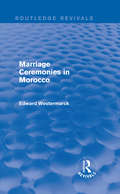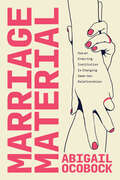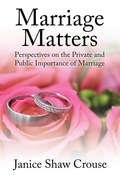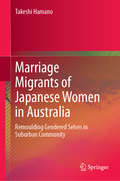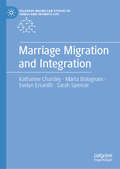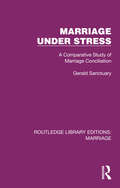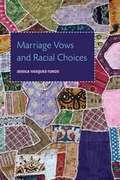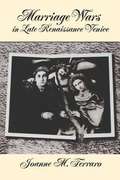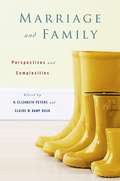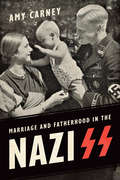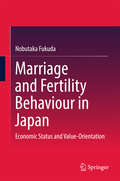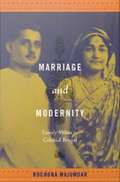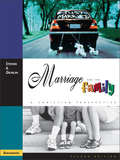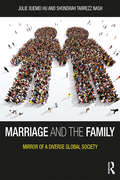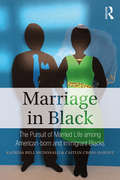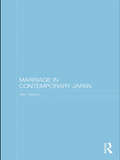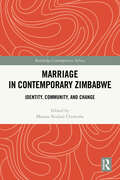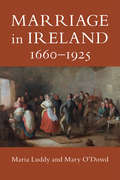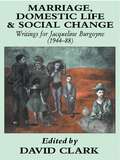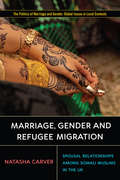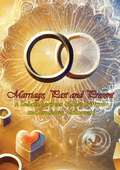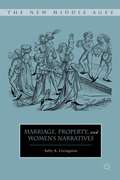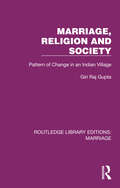- Table View
- List View
Marlowe's Soldiers: Rhetorics of Masculinity in the Age of the Armada (Routledge Revivals)
by Alan ShepardThis title was first published in 2002: In the topsy-turvy 1580s and 1590s, as the episodic Anglo-Spanish war became the greatest threat to "English" security since circa 1066, Marlowe rose up in the London theatres like some Phaeton of the entertainment industry, taking war itself as a central subject of his art. This book reads his plays - especially "Tamburlaine", "Edward II", "The Massacre at Paris", and "Doctor Faustus" - as part of a bright new conversation then taking place in London about the nature of state security and martial law, the decorum of playing "the soldier" on stage, the rhetoric of warfever, and the necessity for draconian prescriptions about English manhood. Those public conversations, spilling out of Whitehall, the church pulpits, and the pubs, took center stage during the few years the playwright worked in London. The author argues that the Marlowe plays wrestle with the philosophical assumptions about the nature of war and the role and status of soldiers in English culture.
Marriage Ceremonies in Morocco (Routledge Revivals)
by Edward WestermarckFirst published in 1914, this title was the first comparative study of the marriage ceremonies in different parts of Morocco. Westermarck considers how ceremonial customs and rituals differ across social and cultural groups throughout the country and discusses their possible roots. Based on extensive primary research, visiting many of the tribes and places mentioned in the book, this is a really fascinating title of great value to students of sociology and cultural anthropology with an interest in the foundations of the marriage ceremony.
Marriage Material: How an Enduring Institution Is Changing Same-Sex Relationships
by Abigail OcobockA cutting-edge study of marriage’s transformative effects on same-sex relationships. It is no secret that marriage rates in the United States are at an all-time low. Despite this significant decline, the institution of marriage endures in our society amid historic changes to its meaning and practice. How does the continuing strength of marriage impact the relationships of same-sex couples after the legalization of same-sex marriage? Drawing on over one hundred interviews with LGBTQ+ people, Marriage Material reveals the transformative impact marriage equality has had on same-sex relationships. Sociologist Abigail Ocobock looks to same-sex couples across a wide age range to illuminate the complex ways institutional mechanisms work in tandem to govern the choices and behaviors of individuals with different marriage experiences. Ocobock examines both the influence of marriage on the dynamics of same-sex relationships and how LGBTQ+ people challenge heteronormative assumptions about marriage, highlighting the complex interplay between institutional constraint and individual agency. Marriage Material presents a bold challenge to dominant scholarly and popular ideas about the decline of marriage, making clear that gaining access to legal marriage has transformed same-sex relationships, both for better and for worse.
Marriage Matters: Perspectives on the Private and Public Importance of Marriage
by Janice CrouseIn Marriage Matters, Janice Shaw Crouse argues that marriage is a critical element in a free society and that society's most vulnerable communities, especially minorities and the poor, suffer the most from the nation's retreat from marriage. Crouse writes that marriage advances the public interest and we should create laws and policies that support rather than undermine it. She demonstrates both the public and private importance of marriage, and organizes her argument in a thoughtful and logical manner. Compared to other household arrangements, Crouse observes, marriage is by far the best for raising children and offers financial advantages as well. Writing about bullying, Crouse shows how the trend away from marriage has lead to poor child-rearing and to some of the nation's worst contemporary problems. In household arrangements with an absence of traditional fathers, the government has in some ways overtaken this role by creating social programs such as food stamps, Social Security, and Medicare. Social programs are but a small part of an effective solution. The groundwork for strong marriages and lasting relationships is examined in detail. Crouse then discusses the role of sex in marriages and the harmful influence of casual sex. The second half of the work shows how marriage matters to individuals (specifically to women and children) and depicts same-sex marriage as a threat to the institution. Other public policy issues affecting marriage are also explored.
Marriage Migrants of Japanese Women in Australia: Remoulding Gendered Selves in Suburban Community
by Takeshi HamanoThis book investigates the experience of Japanese women who have immigrated to Australia through marriage to a local partner. Based on long-term participant observations gathered with a Japanese ethnic association in Sydney, and on in-depth interviews with the association’s members, it examines the ways in which the women remould themselves in Australia by constructing gendered selves that reflect their unique migratory circumstances through cross-border marriage.In turn, the book argues that the women tend to embrace expressions of Japanese femininity that they once viewed negatively, and that this is due to their lack of social skills and access to the cultural capital of mainstream Australian society. Re-molding the self through conventional Japanese notions of gender ironically provides them with a convincing identity: that of minority migrant women. Nevertheless, by analyzing these women’s engagement with a Japanese ethnic association in a suburb of Sydney, the book also reveals a nuanced sense of ambivalence; a tension between the women’s Japanese community and their lives in Australia.Accordingly, the book provides a fresh perspective on interdisciplinary issues of gender and migration in a globalized world, and engages with a wide range of academic disciplines including: sociology of migration; sociology of culture; cultural anthropology; cultural studies; Japanese studies; Asian studies; gender studies; family studies; migration studies and qualitative methodologies.
Marriage Migration and Integration: British South Asian Transnational Marriages And Processes Of Integration (Palgrave Macmillan Studies in Family and Intimate Life)
by Marta Bolognani Sarah Spencer Katharine Charsley Evelyn ErsanilliThis book provides the first sustained empirical evidence on the relationships between marriage migration and processes of integration, focusing on two of the largest British ethnic minority groups involved in these kinds of transnational marriages – Pakistani Muslims and Indian Sikhs. In Britain, and across Europe, concern has been increasingly expressed over the implications of marriage-related migration for integration. Children and grandchildren of former immigrants marrying partners from their ancestral ‘homelands’ is often presented as problematic in forming a 'first generation in every generation,’ and inhibiting processes of individual and group integration, impeding socio-economic participation and cultural change. As a result, immigration restrictions have been justified on the grounds of promoting integration, despite limited evidence. Marriage Migration and Integration provides much needed new grounding for both academic and policy debates. This book draws on both quantitative and qualitative data to compare transnational ‘homeland’ marriages with intra-ethnic marriages within the UK. Using a distinctive holistic model of integration, the authors examine processes in multiple interacting domains, such as employment, education, social networks, extended family living, gender relations and belonging. It will be of use to students and scholars across sociology, social anthropology, and social policy with a focus on migration, integration, family studies, gender, and ethnic studies, as well as policy-makers and service providers in the UK and across Europe.
Marriage Under Stress: A Comparative Study of Marriage Conciliation (Routledge Library Editions: Marriage)
by Gerald SanctuaryIn the 1960s divorce was increasing around the world and marriage conciliation services were a necessary development to deal with those who wanted to seek help for their problems. Originally published in 1968, the purpose of this title was to give some account of the widely differing types of marital conciliation services operating in Britain and also some other parts of the world at the time. The author, who was based at the National Marriage Guidance Council of Great Britain, first outlines the British services, then presents comparative studies of the services overseas in Australia, New Zealand, Scandinavia and Finland and the United States and Canada. Today it can be read and enjoyed in its historical context.
Marriage Vows and Racial Choices
by Jessica Vasquez-TokosChoosing whom to marry involves more than emotion, as racial politics, cultural mores, and local demographics all shape romantic choices. In Marriage Vows and Racial Choices, sociologist Jessica Vasquez-Tokos explores the decisions of Latinos who marry either within or outside of their racial and ethnic groups. Drawing from in-depth interviews with nearly 50 couples, she examines their marital choices and how these unions influence their identities as Americans. Vasquez-Tokos finds that their experiences in childhood, adolescence, and young adulthood shape their perceptions of race, which in turn influence their romantic expectations. Most Latinos marry other Latinos, but those who intermarry tend to marry whites. She finds that some Latina women who had domineering fathers assumed that most Latino men shared this trait and gravitated toward white men who differed from their fathers. Other Latina respondents who married white men fused ideas of race and class and perceived whites as higher status and considered themselves to be “marrying up.” Latinos who married non-Latino minorities—African Americans, Asian Americans, and Native Americans—often sought out non-white partners because they shared similar experiences of racial marginalization. Latinos who married Latinos of a different national origin expressed a desire for shared cultural commonalities with their partners, but—like those who married whites—often associated their own national-origin groups with oppressive gender roles. Vasquez-Tokos also investigates how racial and cultural identities are maintained or altered for the respondents’ children. Within Latino-white marriages, biculturalism—in contrast with Latinos adopting a white “American” identity—is likely to emerge. For instance, white women who married Latino men often embraced aspects of Latino culture and passed it along to their children. Yet, for these children, upholding Latino cultural ties depended on their proximity to other Latinos, particularly extended family members. Both location and family relationships shape how parents and children from interracial families understand themselves culturally. As interracial marriages become more common, Marriage Vows and Racial Choices shows how race, gender, and class influence our marital choices and personal lives.
Marriage Wars in Late Renaissance Venice
by Joanne M. FerraroBased on a fascinating body of previously unexamined archival material, this book brings to life the lost voices of ordinary Venetians during the age of Catholic revival. Looking at scripts that were brought to the city's ecclesiastical courts by spouses seeking to annul their marriage vows,this book opens up the emotional world of intimacy and conflict, sexuality, and living arrangements that did not fit normative models of marriage.
Marriage and Family: Perspectives and Complexities
by H. Elizabeth Peters Claire Kamp DushFamily life has been radically transformed over the past three decades. Half of all households are unmarried, while only a quarter of all married households have kids. A third of the nation's births are to unwed mothers, and a third of America's married men earn less than their wives. With half of all women cohabitating before they turn thirty and gay and lesbian couples settling down with increasing visibility, there couldn't be a better time for a book that tracks new conceptions of marriage and family as they are being formed.The editors of this volume explore the motivation to marry and the role of matrimony in a diverse group of men and women. They compare empirical data from several emerging family types (single, co-parent, gay and lesbian, among others) to studies of traditional nuclear families, and they consider the effect of public policy and recent economic developments on the practice of marriage and the stabilization-or destabilization-of family. Approaching this topic from a variety of perspectives, including historical, cross-cultural, gendered, demographic, socio-biological, and social-psychological viewpoints, the editors highlight the complexity of the modern American family and the growing indeterminacy of its boundaries. Refusing to adhere to any one position, the editors provide an unbiased account of contemporary marriage and family.
Marriage and Family: The Quest for Intimacy
by Jeanette C. Lauer Robert H. LauerThis text combines a positive and practical approach to the study of marriage and family life. It is based on extensive and up-to-date research as reported in the journals and monographs. It shows how sociological theories apply to the various topics. Thus, it not only provides students with a basic understanding of marriage and family life, but also helps them apply this knowledge to enrich their lives and nurture their own intimate relationships.
Marriage and Fatherhood in the Nazi SS (German and European Studies)
by Amy CarneyFrom 1931 to 1945, leaders of the SS, a paramilitary group under the Nazi party, sought to transform their organization into a racially-elite family community that would serve as the Third Reich’s new aristocracy. They utilized the science of eugenics to convince SS men to marry suitable wives and have many children. Marriage and Fatherhood in the Nazi SS, by Amy Carney, is the first work to significantly assess the role of SS men as husbands and fathers during the Third Reich. The family community, and the place of men in this community, started with one simple order issued by SS leader Heinrich Himmler. He and other SS leaders continued to develop the family community throughout the 1930s, and not even the Second World War deterred them from pursuing their racial ambitions. Carney’s insight into the eugenic-based measures used to encourage SS men to marry and to establish families sheds new light on their responsibilities not only as soldiers, but as husbands and fathers as well.
Marriage and Fertility Behaviour in Japan: Economic Status and Value-Orientation
by Nobutaka FukudaThis monograph examines the influence of ideational and socio-economic factors on Japanese marriage and fertility behaviour. It also investigates the historical change in attitudes toward partnership and family in Japan, which, if current trends continue, can lead to population shrinkage and an asymmetrical age structure.The author first details the differences between ideational and economic approaches. He examines these two behavioural models from a viewpoint of rational choice theory, which he then follows with a discussion on the influence of institutional contexts on matrimony and childbirth. Next, the book considers salient features of Japanese marriage behaviour, including the relation between these patterns and changes in society and the influence of marriage on attitudes toward partnership and family relations. Coverage then goes on to explore the influence of ideational factors on fertility and analyse the impact of childbirth on couples' attitudes. The author also investigates attitudinal changes between generations in Japan. He provides a theoretical review on the relation between socio-economic development and value-orientation as well as looks at the difference in attitudes from a viewpoint of cohorts and periods. Overall, the book presents an authoritative, theoretical and empirical analysis using data from panel and repeated cross-sectional surveys. Throughout, the author clearly identifies the sources of his data as well as the methods used in his analysis.
Marriage and Modernity: Family Values in Colonial Bengal
by Rochona MajumdarAn innovative cultural history of the evolution of modern marriage practices in Bengal, Marriage and Modernity challenges the assumption that arranged marriage is an antiquated practice. Rochona Majumdar demonstrates that in the late colonial period Bengali marriage practices underwent changes that led to a valorization of the larger, intergenerational family as a revered, "ancient" social institution, with arranged marriage as the apotheosis of an "Indian" tradition. She meticulously documents the ways that these newly embraced "traditions"--the extended family and arranged marriage--entered into competition and conversation with other emerging forms of kinship such as the modern unit of the couple, with both models participating promiscuously in the new "marketplace" for marriages, where matrimonial advertisements in the print media and the payment of dowry played central roles. Majumdar argues that together the kinship structures newly asserted as distinctively Indian and the emergence of the marriage market constituted what was and still is modern about marriages in India. Majumdar examines three broad developments related to the modernity of arranged marriage: the growth of a marriage market, concomitant debates about consumption and vulgarity in the conduct of weddings, and the legal regulation of family property and marriages. Drawing on matrimonial advertisements, wedding invitations, poems, photographs, legal debates, and a vast periodical literature, she shows that the modernization of families does not necessarily imply a transition from extended kinship to nuclear family structures, or from matrimonial agreements negotiated between families to marriage contracts between individuals. Colonial Bengal tells a very different story.
Marriage and the Family
by Stephen A. GrunlanThis revised and updated, 21st century edition of a widely used textbook discusses the sociology of the family, historical perspective, alternative lifestyles, minority families, mate selection, premarital sex, sexuality, and singleness. It also addresses marital adjustment, communication, conflict resolution, childbearing, parenting, gender roles, aging, finances, and violence. Marriage and the Family uses case studies, discussion questions, suggested reading, glossary, tables, and illustrations to help the reader understand the importance of strong family units in crucial times.
Marriage and the Family: Mirror of a Diverse Global Society
by Julie Xuemei Hu Shondrah Tarrezz NashMarriage and the Family: Mirror of a Diverse Global Society is a comprehensive text about marriage and the family in sociology, family science, and diversity studies. The book is divided into four parts: studying marriage patterns and understanding family diversity; developing and maintaining intimate relationships; tackling family issues and managing household crises; and appreciating contemporary living arrangements in a diverse American society and across the global community. Marriage and the Family is unique in its focus on diversity as well as its global perspective. Diversity Overview boxes feature vignettes of family diversity in America. Global Overview boxes invite students to experience family life in different areas of the world. Indeed, families become a mirror that helps students see a diversifying American society and a globalizing world.
Marriage in Black: The Pursuit of Married Life among American-born and Immigrant Blacks
by Katrina Bell McDonald Caitlin Cross-BarnetDespite the messages we hear from social scientists, policymakers, and the media, black Americans do in fact get married—and many of these marriages last for decades. Marriage in Black offers a progressive perspective on black marriage that rejects talk of black relationship "pathology" in order to provide an understanding of enduring black marriage that is richly lived. The authors offer an in-depth investigation of details and contexts of black married life, and seek to empower black married couples whose intimate relationships run contrary to common—but often inaccurate—stereotypes. Considering historical influences from Antebellum slavery onward, this book investigates contemporary married life among more than 60 couples born after the passage of the Civil Rights Act. Husbands and wives tell their stories, from how they met, to how they decided to marry, to what their life is like five years after the wedding and beyond. Their stories reveal the experiences of the American-born and of black immigrants from Africa or the Caribbean, with explorations of the "ideal" marriage, parenting, finances, work, conflict, the criminal justice system, religion, and race. These couples show us that black family life has richness that belies common stereotypes, with substantial variation in couples’ experiences based on social class, country of origin, gender, religiosity, and family characteristics.
Marriage in Contemporary Japan (Routledge Contemporary Japan Series)
by Yoko TokuhiroThe phenomenon of bankonka – ‘postponement of marriage’ – is increasingly reported in contemporary Japanese media, clearly illustrating the changing patterns of modern lifestyles and attitudes towards marriage, personal obligation and ambition. This is the first book in recent years to explore the contemporary state of marriage in Japanese society. Setting out the different perceptions and expectations of marriage in today’s Japan, the book discusses how economic issues and the family impact on marital behaviour. Contrary to the views of some feminists that young women have no interest in improving their status and position, this book argues that, by delaying marriage and childrearing, young women can be seen as ‘rebels’ challenging Japanese patriarchal society. Unlike many other studies, it gives equal attention to male gender roles and masculinity, exploring what constitutes being a ‘real man’ in Japan – through the analysis of mainstream and non-mainstream conceptions of masculinity that co-exist in contemporary Japan, and considers the implications of such different roles for the institution of marriage. It investigates the roles of wife and mother, articulating why the strict division of labour defining men as breadwinners and women as homemakers became popular. Moreover, it describes the changing character of courtship relationships, explaining why the norm has shifted from arranged marriages pre-1945 to love marriages after that period. Finally, it puts the Japanese experience into cross-cultural, international context with a series of comparisons with marriage elsewhere both in Asia – including in Korea and Hong Kong – and in western countries such as France, Sweden, Italy and the United States.
Marriage in Contemporary Zimbabwe: Identity, Community, and Change (Routledge Contemporary Africa)
by Manase Kudzai ChiwesheMarriage has always occupied a profound cultural and social significance in Zimbabwean society, but the forms and meanings attached to marriage have changed in recent decades. Marriage in Contemporary Zimbabwe provides a social analysis of the institution, highlighting how it is changing and evolving in the face of societal factors such as globalisation, technology, increased migration, religious plurality, and shifting cultural systems.This book traces the evolution of Zimbabwean marriages from traditional pre-colonial customs into the diverse modern practices seen today. Drawing on rich qualitative insights from across urban, rural, and diaspora communities, it explores the shift in traditional ascribed gender roles, and the complex negotiations between persisting tradition and emerging modern influences. These influences include women’s empowerment, partner choice, and divorce. It explores changes in childrearing and the dissolution of the extended family networks that once governed marriages and provided mutual support. The book also explores broader societal transformations such as urban migration and westernisation, and the impact of socioeconomic challenges such as HIV/AIDS, COVID-19, poverty, and economic hardship.Students and scholars of Zimbabwean history, culture, gender, and the family will find this book essential for understanding the continuities and evolutions of the marriage institution in Zimbabwe.
Marriage in Ireland, 1660–1925
by Maria Luddy Mary O'DowdWhat were the laws on marriage in Ireland, and did church and state differ in their interpretation? How did men and women meet and arrange to marry? How important was patriarchy and a husband's control over his wife? And what were the options available to Irish men and women who wished to leave an unhappy marriage? This first comprehensive history of marriage in Ireland across three centuries looks below the level of elite society for a multi-faceted exploration of how marriage was perceived, negotiated and controlled by the church and state, as well as by individual men and women within Irish society. Making extensive use of new and under-utilised primary sources, Maria Luddy and Mary O'Dowd explain the laws and customs around marriage in Ireland. Revising current understandings of marital law and relations, Marriage in Ireland, 1660–1925 represents a major new contribution to Irish historical studies.
Marriage, Domestic Life and Social Change: Writings for Jacqueline Burgoyne, 1944-88
by David ClarkMarriage, Domestic Life and Social Change brings together leading writers on marriage and the family in a tribute to the life and work of Jacqueline Burgoyne, a major figure in family studies.
Marriage, Gender and Refugee Migration: Spousal Relationships among Somali Muslims in the United Kingdom (Politics of Marriage and Gender: Global Issues in Local Contexts)
by Natasha CarverThis ethical and poetic ethnography analyses the upheavals to gender roles and marital relationships brought about by Somali refugee migration to the UK. Unmoored from the socio-cultural norms that made them men and women, being a refugee is described as making "everything" feel "different, mixed up, upside down." Marriage, Gender and Refugee Migration details how Somali gendered identities are contested, negotiated, and (re)produced within a framework of religious and politico-national discourses, finding that the most significant catalysts for challenging and changing harmful gender practices are a combination of the welfare system and Islamic praxis. Described as “an important and urgent monograph," this book will be a key text relevant to scholars of migration, transnational families, personal life, and gender. Written in a beautiful and accessible style, the book voices the participants with respect and compassion, and is also recommended for scholars of qualitative social research methods.
Marriage, Past and Present: A Debate between Robert Briffault and Bronislaw Malinowski
by Bronislaw Malinowski Robert BriffaultDelve into the fascinating and thought-provoking world of anthropological and sociological discourse with Marriage, Past and Present: A Debate between Robert Briffault and Bronislaw Malinowski. This compelling work captures the intellectual clash between two of the early 20th century's most prominent scholars as they explore the evolution and significance of marriage in human societies.Robert Briffault, a noted anthropologist and sociologist, and Bronislaw Malinowski, a pioneering figure in social anthropology, bring their distinctive perspectives and expertise to this vigorous debate. Through a series of essays and counterarguments, they examine the historical development of marriage, its cultural variations, and its role in contemporary society.Briffault, known for his critical views on the institution of marriage, argues that marriage has evolved primarily as a social contract influenced by economic and political factors. He challenges traditional notions of marriage as a natural and universal institution, proposing instead that it is a construct shaped by specific historical and cultural contexts.In contrast, Malinowski, celebrated for his fieldwork and functionalist approach, defends the idea of marriage as a fundamental and universal aspect of human societies. He emphasizes the biological and social functions of marriage, including the regulation of sexual relations, the rearing of children, and the establishment of kinship networks.Join Robert Briffault and Bronislaw Malinowski in this enlightening and engaging exploration of marriage, and discover the varied interpretations and meanings of this enduring social institution. Marriage, Past and Present is a timeless contribution to the study of human relationships and cultural evolution.
Marriage, Property, and Women’s Narratives
by Sally A. LivingstonAn interdisciplinary approach to the study of women and property, combining literature, history, and economics. By looking at women's marriage narratives over a long period of time, the book reveals the deep discontent with the institution of property ownership as a unifying thread from the Middle Ages up through the twentieth-century.
Marriage, Religion and Society: Pattern of Change in an Indian Village (Routledge Library Editions: Marriage)
by Giri Raj GuptaOriginally published in 1974, the conclusions of the book are based on intensive field-work during 1963-66 in a village in south-east Rajasthan, India. Although the marriages of 158 boys and 163 girls were studied, the relevance of the conclusions drawn extends far beyond the village and its region since it reveals the changing themes and values in Indian society at the time. The perceptive analysis of rites and ceremonies of marriage further illuminates the central problem of the book – how the themes of the Dharmasastras are interpreted and acted upon in village life and what kinds of reinforcements and incentives to change they provide to the various units of social structure. The author contends that the series of marriage rites manifest the continuity of tradition, a ritual epitomisation of caste interdependence and means of systematic social advancement. At the time ritual idioms and patterns of social exchange were beginning to change, more often in observance than in content. Traditional sources of status aggrandisement continued to provide new pathways to the forces of modernisation and unveil several clues to the innovative strategies of change. This scholarly study filled the need for a realistic appraisal of the relationship between marriage practices, religious values and the changing social structure.

